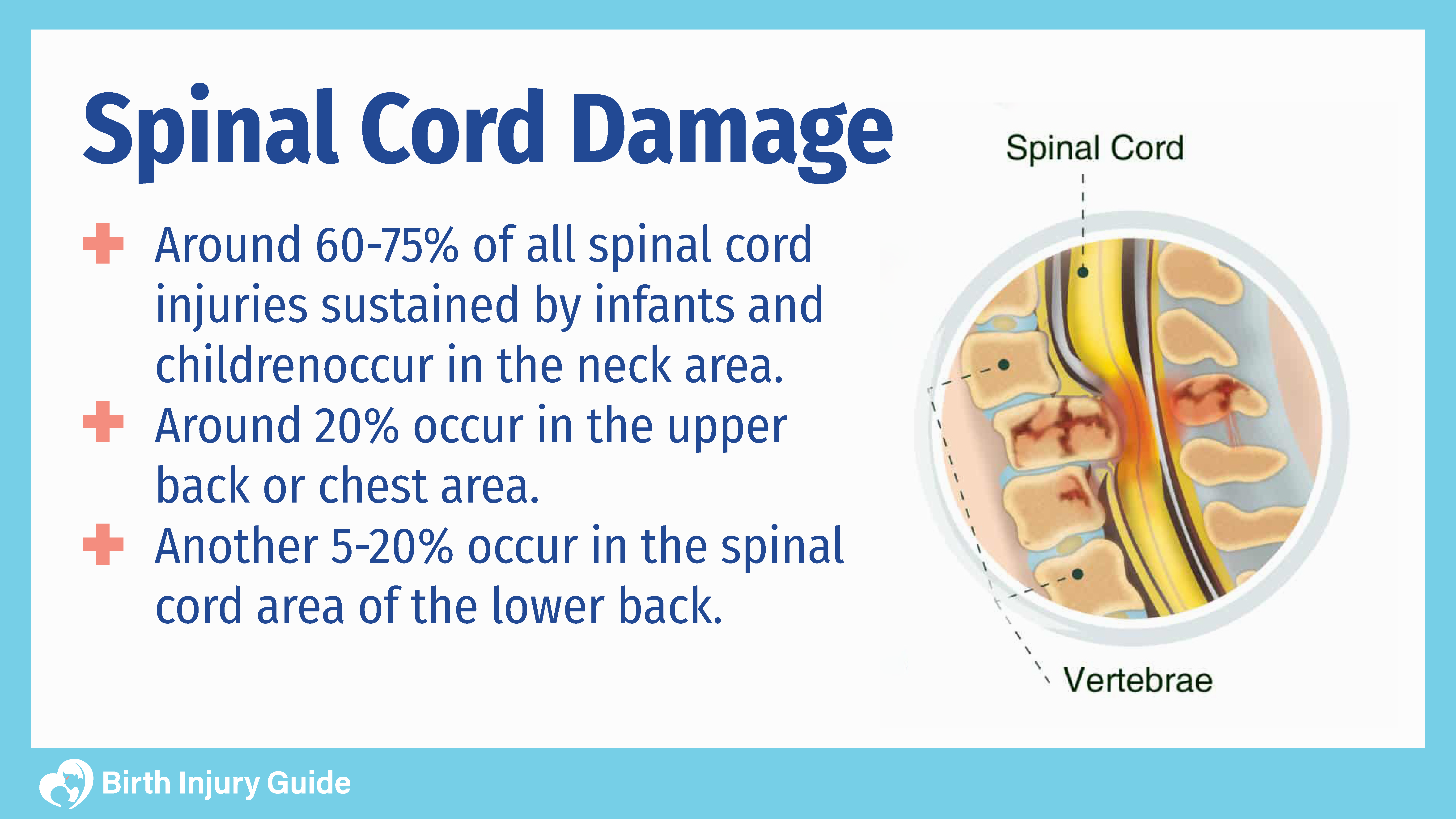
Infant Spinal Cord Damage
Infant spinal cord damage is rare, accounting for only five percent of all spinal cord damage cases in the United States. When they do occur, however, the results of such a traumatic injury can leave children with a host of medical issues. It may be frightening to learn that your infant’s spinal cord was damaged, but by educating yourself on the causes, treatment options, and long-term outlook, you’ll be better equipped in knowing what to expect and how to help your baby.
What is Infant Spinal Cord Damage?
Spinal cord damage occurs when mechanical force or a medical malady affects the infant’s spine during labor and delivery. Birth trauma that leads to an infant spinal cord injury may be the result of medical negligence.

Generally, the higher up on the body that the injury occurs, the more serious the damage will be.
What Causes Infant Spinal Cord Damage?
Birth trauma is the most common cause of infant spinal cord damage during labor and delivery. These injuries often affect the cervical and thoracic sections of the back, which are near the neck and mid/upper back. If the infant is in a breech position, however, spinal cord injuries are more likely to affect the lower cervical area of the spine.
There are a variety of risk factors during pregnancy, labor and delivery that cause or increase the risk of a spinal cord injury. These include:
- Abnormal fetal presentation (most often breech position)
- Excessive traction
- Cephalopelvic disproportion
- Prolonged labor
- Macrosomia
- Oligohydramnios
- Forceps delivery injury
- Vacuum extraction injury
- Low birth weight
- Premature labor or delivery
- Shoulder dystocia
Spinal cord damage can also come from a lack of diagnosis or a misdiagnosis of spina bifida, a condition in which the vertebrae does not completely enclose the raw nerves of the spine. If the child has spina bifida – especially myelomeningocele, the nerves of the spinal column are at risk of injury when the medical staff is unaware of the condition and touches or damages the nerves.
Symptoms of Infant Spinal Cord Damage
Symptoms of infant spinal cord damage will vary depending on what part of the spinal cord was injured and how severe the damage is. An infant with a spinal cord injury may experience some or all of the following symptoms:
- Loss of sensation in the arms, legs or chest
- Inability to move or difficulty moving
- Bowel and bladder control problems (which is difficult to determine with infants)
- Difficulty regulating body temperature, heart rate and blood pressure
- Abnormal reflexes
- Spasms
- Stinging pains, caused by nerve damage around the spinal cord
- Difficulties with breathing
- Weakness
Tests to Confirm Spinal Cord Damage Diagnosis
If doctors suspect that your infant has spinal cord damage, he or she will start by conducting a thorough medical evaluation. In addition to a physical examination, your doctor may order tests, such as:
- Magnetic resonance imaging (MRI)
- Computed tomography (CT scan)
- X-Ray
- Bloodwork
Infant Spinal Cord Damage Treatment
Spinal cord injuries often cause permanent damage. However, there are many medical interventions that can minimize or control symptoms and maximize function. It is important that treatment be initiated quickly for best results. Depending on your child’s injury, your doctor may recommend one or more of the following treatments:
- Immobilization
- Physical therapy
- Occupational therapy
- Surgery
- Medications
- Corticosteroids
- Methylprednisolone
- Acetyl-1-Carnitine
Doctors should monitor your child closely during treatment to watch for signs of possible complications. Spinal cord injuries can cause complications affecting blood pressure, body temperature regulation and function of the vital organs.
In addition to treatment, there are some supportive measures that can help your child recover as comfortably and effectively as possible. Such measures include:
- Mechanical ventilation
- Feeding tube
- Bladder catheterization
Prognosis for Infant Spinal Cord Damage
The prognosis for infant spinal cord damage will depend on the injury, the child’s overall health and other factors. According to the National Institutes of Health (NIH), the prognosis of spinal cord damage will depend on if the injury was complete or incomplete. If an injury is incomplete, there is still a way for the brain to communicate and send messages to the spinal cord. That means that motor and sensory function may still be obtainable.
If the injury is complete, however, there is total loss of the sensory and motor functions below the injury level. Therefore, the prognosis for recovery is less favorable. An unfortunate reality is that some children never completely recover from spinal cord damage. In some instances, spinal cord damage can cause paralysis. In others, it can lead to disabilities that last a lifetime. Sadly, in the most severe cases, a spinal cord injury can even be fatal.
Spinal cord damage that is not severe will generally result in a more favorable outcome. In many cases, the infant may be immobile while healing and may require use of an orthotic brace, lumbar brace or other type of device that promotes healing.
Keep in mind that these are general guidelines. For specific questions pertaining to your baby’s injuries, be sure to consult with a qualified physician.
How to Optimize Your Child’s Prognosis
One of the best ways to optimize your child’s prognosis is to make sure that your child has access to treatment and support immediately. Often, children with a spinal cord injury benefit from a multidisciplinary healthcare team who can assess and treat all aspects of the injury. Working with a team of healthcare providers can help improve independence, improve strength and mobility and manage pain. Ultimately, this will help your child have the best quality of life possible.



